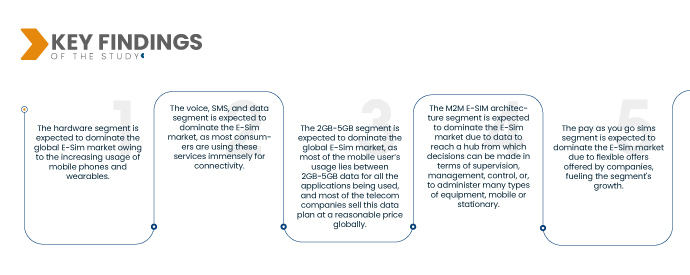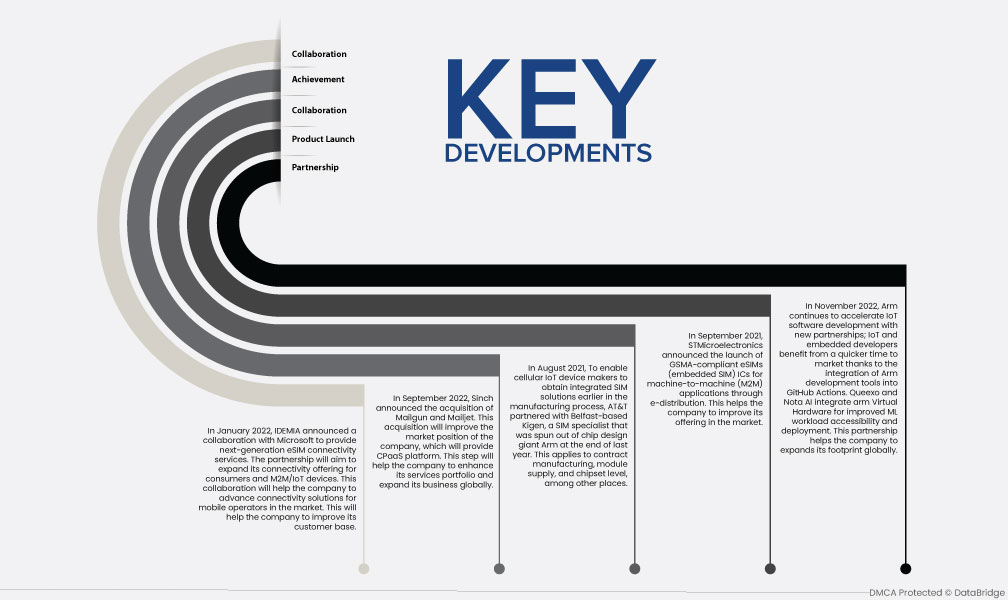IoT-Geräte, zu denen zahlreiche Geräte im Internet der Dinge gehören, sind nicht standardisierte Computer, die sich drahtlos mit einem Netzwerk verbinden und Daten übertragen können (IoT ). IoT erweitert die Internetkonnektivität auf eine Vielzahl herkömmlicher, nicht internetfähiger physischer Gegenstände und Alltagsgegenstände, zusätzlich zu herkömmlichen Geräten wie Desktops, Laptops, Smartphones und Tablets. Diese Geräte können sich online verbinden und kommunizieren, da sie technologisch eingebettet sind. Sie können auch aus der Ferne überwacht und verwaltet werden.
Den vollständigen Bericht finden Sie unter @ https://www.databridgemarketresearch.com/reports/global-esim-market
Data Bridge Market Research analysiert, dass der E-Sim-Markt im Prognosezeitraum von 2023 bis 2027 voraussichtlich mit einer durchschnittlichen jährlichen Wachstumsrate (CAGR) von 14,3 % wachsen und bis 2027 voraussichtlich 3.029.965,66 Tausend USD erreichen wird. Daher ist die zunehmende Beliebtheit von Machine-to-Machine-SIM-Anwendungen (M2M-SIM) einer der Wachstumsfaktoren des E-Sim-Marktes und eine wichtige Priorität für die Zukunft der Mobilfunknetzbetreiber (MNOs).
Wichtigste Ergebnisse der Studie
Die schnelle Einführung von IoT-verbundenen Geräten in der Unterhaltungselektronik und M2M-Anwendungen dürfte das Marktwachstum ankurbeln
Mobilfunkbetreiber profitieren vom Ausbau E-SIM-fähiger M2M -Geräte und der steigenden Beliebtheit von E-SIM bei M2M-Unternehmenskunden. Die neue Technologie dürfte entscheidend zur Vernetzung von Smart Cities, Smart Metern, eHealth, Smart Cars, Flottenmanagement, Sicherheitssystemen und anderen Branchen beitragen, die IoT-Konzepte zur Steigerung von Effizienz und Effektivität nutzen. Diese Unternehmenskunden und ihre M2M-Verbindungen bedeuten für die Netzbetreiber zahlreiche Verbindungen und hohe Umsätze.
Berichtsumfang und Marktsegmentierung
Berichtsmetrik
|
Details
|
Prognosezeitraum
|
2023 bis 2027
|
Basisjahr
|
2022
|
Historische Jahre
|
2021 (Anpassbar auf 2020–2016)
|
Quantitative Einheiten
|
Umsatz in Tausend USD, Mengen in Einheiten, Preise in USD
|
Abgedeckte Segmente
|
Nach Komponente (Hardware, Dienste), Konnektivität (Sprache, SMS und Daten und nur Daten), Datentarif (2–5 GB, 5–10 GB, 10–25 GB, weniger als 2 GB und mehr als 25 GB), Architektur (M2M-E-SIM-Architektur und E-SIM-Architektur für Unterhaltungselektronik ), Preismodelle (Pay-As-You-Go-SIMs und Pay-Monthly-SIMs), Netzwerktyp (öffentlich, privat ), Bereitstellungsmodell (vor Ort und in der Cloud), kompatibles Gerät (Mobiltelefone, Tablets, Laptops, Wearables, Smart Meter und IoT), Endbenutzer (Unterhaltungselektronik, Automobilindustrie, Fertigung, Einzelhandel, Energie- und Versorgungsunternehmen, Transport und Logistik, Wohnen, Sport und Unterhaltung, Landwirtschaft und andere).
|
Abgedeckte Länder
|
USA, Kanada und Mexiko, China, Japan, Indien, Philippinen, Südkorea, Australien und Neuseeland, Singapur, Thailand, Indonesien, Malaysia, Vietnam, Taiwan, Rest des asiatisch-pazifischen Raums, Großbritannien, Deutschland, Frankreich, Italien, Niederlande, Spanien, Schweiz, Russland, Schweden, Dänemark, Belgien, Türkei, Polen, Norwegen, Estland, Rest von Europa, Saudi-Arabien, Vereinigte Arabische Emirate, Algerien, Ägypten, Marokko, Tunesien, Israel, Südafrika, Äthiopien, Namibia, Nigeria, Uganda, Kenia, Sambia, Mauritius, Angola und Rest des Nahen Ostens und Afrikas.
|
Abgedeckte Marktteilnehmer
|
Telefónica (Madrid, Spanien), Semtech Corporation (Kalifornien, USA), Giesecke+Devrient GmbH (München, Deutschland), AT&T (Texas, USA), Orange (Issy-les-Moulineaux, Frankreich), Arm Limited (England, Großbritannien), KORE Wireless (Georgia, USA), Workz (Dubai, VAE), Oasis Smart-SIM (Île-de-France, Frankreich), Vodafone Group (England, Großbritannien), STMicroelectronics (Genf, Schweiz), Thales (Paris, Frankreich), Deutsche Telekom AG (Bonn, Deutschland), NXP Semiconductors (Eindhoven, Niederlande), Infineon Technologies AG (Neubiberg, Deutschland), Telit (Kalifornien, USA), IDEMIA (Courbevoie, Frankreich), TP Global Operations Limited (London, Großbritannien), Sinch (Stockholm, Schweden), Singte (Kalifornien, USA), Etisalat (Abu Dhabi, VAE), unter anderem.
|
Im Bericht behandelte Datenpunkte
|
Zusätzlich zu den Einblicken in Marktszenarien wie Marktwert, Wachstumsrate, Segmentierung, geografische Abdeckung und wichtige Akteure umfassen die von Data Bridge Market Research kuratierten Marktberichte auch ausführliche Expertenanalysen, Patientenepidemiologie, Pipeline-Analysen, Preisanalysen und regulatorische Rahmenbedingungen.
|
Segmentanalyse:
Der globale E-Sim-Markt ist in neun wichtige Segmente unterteilt, die auf Komponente, Konnektivität, Datentarif, Preismodell, Architektur, Netzwerktyp, Bereitstellungsmodus, kompatiblem Gerät und Endbenutzer basieren.
- Auf der Grundlage der Komponenten ist der globale E-Sim-Markt in Hardware und Dienstleistungen segmentiert
Im Jahr 2023 wird das Hardwaresegment voraussichtlich den globalen E-Sim-Markt dominieren, da in diesem Segment zunehmend Mobiltelefone und Wearables zum Einsatz kommen.
- Der globale E-SIM-Markt ist nach kompatiblen Geräten in Mobiltelefone, Tablets, Laptops, Wearables, Smart Meter und IoT unterteilt. Mobiltelefone werden weiter in Apple und Android unterteilt. IoT wiederum unterteilt sich in Sicherheitssysteme, IoT-Geräte zur Anlagenortung, Hausautomation, vernetzte Fahrzeuge, tragbare POS-Systeme (Point of Scale), medizinische IoT-Geräte und mehr. 2023 wird das Mobiltelefonsegment voraussichtlich den E-SIM-Markt dominieren. Dies ist der am stärksten wachsende Trend bei jungen Menschen und treibt das Wachstum des Segments voran.
Im Jahr 2023 wird das Cloud-Segment voraussichtlich den E-Sim-Markt dominieren. Dies ermöglicht es Benutzern, sich über das Internet mit Cloud-basierten Apps zu verbinden und diese zu verwenden, was das Wachstum des Segments vorantreibt.
- Auf der Grundlage des Endbenutzers ist der globale E-Sim-Markt in die Bereiche Unterhaltungselektronik, Automobil, Fertigung, Einzelhandel, Energie und Versorgung, Transport und Logistik, Wohnen, Sport und Unterhaltung sowie Landwirtschaft und andere unterteilt.
- Auf der Grundlage der Architektur ist der globale E-Sim-Markt in M2M-E-Sim-Architektur und E-Sim-Architektur für Unterhaltungselektronik segmentiert.
- Auf der Grundlage der Konnektivität ist der globale E-Sim-Markt in „Nur Daten“ und „Sprache, SMS und Daten“ segmentiert.
- Auf der Grundlage des Datentarifs ist der globale E-Sim-Markt in weniger als 2 GB, 2 GB–5 GB, 5 GB–10 GB, 10 GB–25 GB und mehr als 25 GB unterteilt.
- Auf der Grundlage des Preismodells ist der globale E-Sim-Markt in SIM-Karten mit monatlicher Zahlung und SIM-Karten mit Prepaid-Zahlung unterteilt.
- Auf der Grundlage des Netzwerktyps ist der globale E-Sim-Markt in öffentliche und private unterteilt
- Auf der Grundlage des Bereitstellungsmodells ist der globale E-SIM-Markt in „On-Premises“ und „Cloud“ segmentiert .
Hauptakteure
Data Bridge Market Research erkennt die folgenden Unternehmen als die wichtigsten Akteure auf dem Markt an: Telefónica, Semtech Corporation, Giesecke+Devrient GmbH, AT&T, Orange, Arm Limited, KORE Wireless, Workz, Oasis Smart-SIM, Vodafone Group, STMicroelectronics, Thales, Deutsche Telekom AG, NXP Semiconductors, Infineon Technologies AG, Telit, IDEMIA, TP Global Operations Limited, Sinch, Singtel, Etisalat und andere.
Marktentwicklung
- Im Januar 2022 gab IDEMIA die Zusammenarbeit mit Microsoft bekannt, um eSIM-Konnektivitätsdienste der nächsten Generation anzubieten. Ziel der Zusammenarbeit ist es, das Konnektivitätsangebot für Verbraucher- und M2M/IoT-Geräte zu erweitern. Die Zusammenarbeit wird dem Unternehmen helfen, fortschrittliche Konnektivitätslösungen für Mobilfunkbetreiber auf den Markt zu bringen und so seinen Kundenstamm zu erweitern.
- Im September 2021 gab Sinch die Übernahme von Mailgun und Mailjet bekannt. Diese Übernahme stärkt die Marktposition des Unternehmens, das eine CPaaS-Plattform anbieten wird. Dieser Schritt wird dem Unternehmen helfen, sein Dienstleistungsportfolio zu erweitern und sein Geschäft weltweit auszubauen.
- Im September 2021 kündigte STMicroelectronics die Einführung GSMA-konformer eSIM-ICs (Embedded SIM) für Machine-to-Machine-Anwendungen (M2M) über den elektronischen Vertrieb an. Dies hilft dem Unternehmen, sein Marktangebot zu verbessern.
- Im November 2022 beschleunigt Arm die IoT-Softwareentwicklung durch neue Partnerschaften weiter. IoT- und Embedded-Entwickler profitieren dank der Integration der Arm-Entwicklungstools in GitHub Actions von einer schnelleren Markteinführung. Die Arm Virtual Hardware wird von Queexo und Nota AI integriert, um die Zugänglichkeit und Bereitstellung von ML-Workloads zu verbessern. Diese Partnerschaft hilft dem Unternehmen, seine Präsenz weltweit auszubauen.
- Im März 2021 ist die Giesecke+Devrient GmbH eine Partnerschaft mit SIM Local eingegangen, um die Verbreitung von E-SIMs weltweit zu fördern. Unternehmen können so den Kernkompetenzbetreibern eSIM-Dienste online oder im stationären Handel anbieten. Diese Schritte werden den Unternehmen helfen, ihren Umsatz in den kommenden Jahren zu steigern.
- Im Februar 2021 kooperiert KORE mit Kigen und Energy Web, um ein integriertes, eSIM-basiertes, vertrauenswürdiges Identitätssystem für Smart-Grid-Anwendungen bereitzustellen. Durch den Einsatz von eSIM- und Multi-IMSI-Technologien bietet KOREs preisgekrönte OmniSIM-Lösung Kunden wie Energy Web zuverlässige und zukunftssichere Konnektivität. Sicherheitsrisiken werden mit der zunehmenden Verbreitung des IoT immer wichtiger. Diese Zusammenarbeit stärkt das Vertrauen der Kunden und die globale Präsenz des Unternehmens.
Regionale Analyse
Geografisch betrachtet sind die im globalen E-Sim-Marktbericht abgedeckten Länder die USA, Kanada und Mexiko, China, Japan, Indien, die Philippinen, Südkorea, Australien und Neuseeland, Singapur, Thailand, Indonesien, Malaysia, Vietnam, Taiwan, der übrige asiatisch-pazifische Raum, Großbritannien, Deutschland, Frankreich, Italien, die Niederlande, Spanien, die Schweiz, Russland, Schweden, Dänemark, Belgien, die Türkei, Polen, Norwegen, Estland, das übrige Europa, Saudi-Arabien, die Vereinigten Arabischen Emirate, Algerien, Ägypten, Marokko, Tunesien, Israel, Südafrika, Äthiopien, Namibia, Nigeria, Uganda, Kenia, Sambia, Mauritius, Angola sowie der übrige Nahe Osten und Afrika, Brasilien, Argentinien und das übrige Südamerika.
Laut Marktforschungsanalyse von Data Bridge:
Nordamerika ist die dominierende Region im globalen E-SIM-Markt im Prognosezeitraum 2023–2027
Im Jahr 2022 dominierte Nordamerika den globalen E-SIM-Markt aufgrund höherer Unternehmensinvestitionen und der zunehmenden Verbreitung von Vernetzungsprozessen. Nordamerika wird den E-SIM-Markt in Bezug auf Marktanteil und Umsatz weiterhin dominieren und seine Dominanz im Prognosezeitraum weiter ausbauen. Dies ist auf die zunehmende Verbreitung fortschrittlicher Technologien und die Einführung neuer Produkte in dieser Region zurückzuführen.
Europa wird im Prognosezeitraum 2023–2027 voraussichtlich die am schnellsten wachsende Region auf dem globalen E-SIM-Markt sein.
Europa dürfte im Prognosezeitraum aufgrund der Präsenz wichtiger Marktteilnehmer und der rasanten Entwicklung von Outsourcing-Möglichkeiten in den Schwellenländern der Region wachsen. Darüber hinaus dürften steigende Unternehmensausgaben und ein steigendes Pro-Kopf-Einkommen das Marktwachstum in dieser Region ankurbeln.
Für detailliertere Informationen zum Marktbericht klicken Sie hier – https://www.databridgemarketresearch.com/reports/global-esim-market












